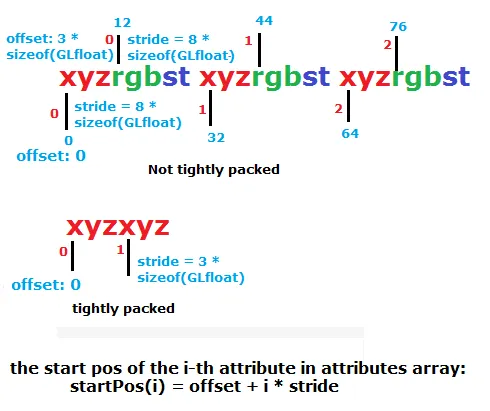由于glVertexAttribPointer经常会出问题,我在这里尝试进一步解释它。
计算属性数组中第i个属性的起始位置的公式为:
startPos(i) = offset + i * stride(来自derhass的另一个答案)
并在下面的图表中进行了说明:

如果您需要代码示例,请继续阅读。
从格式化VBO数据,我们知道可以用三种格式来管理顶点数据。以三角形为例,混合了顶点颜色和纹理颜色,这里是准备顶点属性数据的方法:
#way1 每个属性一个VBO。
此格式类似于:(xyzxyz...)(rgbrgb...)(stst....),我们可以让sride = 0和offset = 0。
void prepareVertData_moreVBO(GLuint& VAOId, std::vector<GLuint>& VBOIdVec)
{
GLfloat vertPos[] = {
-0.5f, 0.0f, 0.0f, 0.5f, 0.0f, 0.0f, 0.0f, 0.5f, 0.0f,
};
GLfloat vertColor[] = {
1.0f, 0.0f, 0.0f, 0.0f, 1.0f, 0.0f, 0.0f, 0.0f, 1.0f,
};
GLfloat vertTextCoord[] = {
0.0f, 0.0f, 1.0f, 0.0f, 1.0f, 1.0f
};
GLuint VBOId[3];
glGenVertexArrays(1, &VAOId);
glBindVertexArray(VAOId);
glGenBuffers(3, VBOId);
glBindBuffer(GL_ARRAY_BUFFER, VBOId[0]);
glBufferData(GL_ARRAY_BUFFER, sizeof(vertPos), vertPos, GL_STATIC_DRAW);
glVertexAttribPointer(0, 3, GL_FLOAT, GL_FALSE, 0, NULL);
glEnableVertexAttribArray(0);
glBindBuffer(GL_ARRAY_BUFFER, VBOId[1]);
glBufferData(GL_ARRAY_BUFFER, sizeof(vertColor), vertColor, GL_STATIC_DRAW);
glVertexAttribPointer(1, 3, GL_FLOAT, GL_FALSE, 0, NULL);
glEnableVertexAttribArray(1);
glBindBuffer(GL_ARRAY_BUFFER, VBOId[2]);
glBufferData(GL_ARRAY_BUFFER, sizeof(vertTextCoord), vertTextCoord, GL_STATIC_DRAW);
glVertexAttribPointer(2, 2, GL_FLOAT, GL_FALSE, 0, NULL);
glEnableVertexAttribArray(2);
glBindBuffer(GL_ARRAY_BUFFER, 0);
glBindVertexArray(0);
VBOIdVec.push_back(VBOId[0]);
VBOIdVec.push_back(VBOId[1]);
VBOIdVec.push_back(VBOId[2]);
}
#way2: 每个属性是顺序存储的,批量存储在单个VBO中.
这种格式类似于:(xyzxyzxyz... rgbrgb... ststst...),我们可以让stride=0,但需要指定offset。
void prepareVertData_seqBatchVBO(GLuint& VAOId, std::vector<GLuint>& VBOIdVec)
{
GLfloat vertices[] = {
-0.5f, 0.0f, 0.0f, 0.5f, 0.0f, 0.0f, 0.0f, 0.5f, 0.0f,
1.0f, 0.0f, 0.0f, 0.0f, 1.0f, 0.0f, 0.0f, 0.0f, 1.0f,
0.0f, 0.0f, 1.0f, 0.0f, 1.0f, 1.0f
};
GLuint VBOId;
glGenVertexArrays(1, &VAOId);
glBindVertexArray(VAOId);
glGenBuffers(1, &VBOId);
glBindBuffer(GL_ARRAY_BUFFER, VBOId);
glBufferData(GL_ARRAY_BUFFER, sizeof(vertices), vertices, GL_STATIC_DRAW);
glVertexAttribPointer(0, 3, GL_FLOAT, GL_FALSE, 0, (GLvoid*)0);
glEnableVertexAttribArray(0);
glVertexAttribPointer(1, 3, GL_FLOAT, GL_FALSE, 0, (GLvoid*)(9 * sizeof(GLfloat)));
glEnableVertexAttribArray(1);
glVertexAttribPointer(2, 2, GL_FLOAT, GL_FALSE, 0, (GLvoid*)(18 * sizeof(GLfloat)));
glEnableVertexAttribArray(2);
glBindBuffer(GL_ARRAY_BUFFER, 0);
glBindVertexArray(0);
VBOIdVec.push_back(VBOId);
}
#第三种方式:在单个VBO中交错属性
这个格式类似于:(xyzrgbstxyzrgbst...),我们需要手动指定偏移量和步长。
void prepareVertData_interleavedBatchVBO(GLuint& VAOId, std::vector<GLuint>& VBOIdVec)
{
GLfloat vertices[] = {
-0.5f, 0.0f, 0.0f, 1.0f, 0.0f, 0.0f, 0.0f, 0.0f,
0.5f, 0.0f, 0.0f, 0.0f, 1.0f, 0.0f, 1.0f, 0.0f,
0.0f, 0.5f, 0.0f, 0.0f, 0.0f, 1.0f, 1.0f, 1.0f,
};
GLuint VBOId;
glGenVertexArrays(1, &VAOId);
glBindVertexArray(VAOId);
glGenBuffers(1, &VBOId);
glBindBuffer(GL_ARRAY_BUFFER, VBOId);
glBufferData(GL_ARRAY_BUFFER, sizeof(vertices), vertices, GL_STATIC_DRAW);
glVertexAttribPointer(0, 3, GL_FLOAT, GL_FALSE,8 * sizeof(GLfloat), (GLvoid*)0);
glEnableVertexAttribArray(0);
glVertexAttribPointer(1, 3, GL_FLOAT, GL_FALSE,
8 * sizeof(GLfloat),(GLvoid*)(3 * sizeof(GLfloat)));
glEnableVertexAttribArray(1);
glVertexAttribPointer(2, 2, GL_FLOAT, GL_FALSE,
8 * sizeof(GLfloat), (GLvoid*)(6 * sizeof(GLfloat)));
glEnableVertexAttribArray(2);
glBindBuffer(GL_ARRAY_BUFFER, 0);
glBindVertexArray(0);
VBOIdVec.push_back(VBOId);
}
感谢 Derhass 的答案。

sizeof(GL_FLOAT)looks incorrect and works by accident. Should besizeof(GLfloat)- Hertz